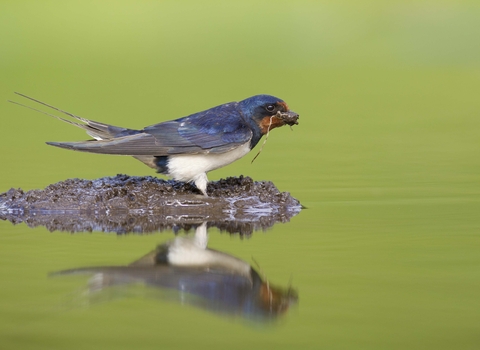
©Mark Hamblin/2020VISION
Swallow
Look out for the swallow performing great aerial feats as it catches its insect-prey on the wing. You may also see it perching on a wire, or roosting in a reedbed, as it makes its way back to Africa for the winter.
Enw gwyddonol
Hirundo rusticaPryd i'w gweld
March to OctoberSpecies information
Ystadegau
Length: 18cmWingspan: 34cm
Weight: 19g
Average lifespan: 2 years
Classified in the UK as Green under the Birds of Conservation Concern 5: the Red List for Birds (2021).
Ynghylch
The swallow, or 'barn swallow', is a common summer visitor, arriving in April and leaving in October. It builds mud and straw nests on ledges, often in farm buildings and outhouses, or under the eaves of houses. Swallows are widespread and common birds of farmland and open pasture near water. They are agile fliers, feeding on flying insects while on the wing. Before they migrate back to their wintering grounds in Africa, they can be seen gathering to roost in wetlands, particularly reedbeds.Sut i'w hadnabod
The swallow is a glossy, dark blue-black above and white below, with a dark red forehead and throat, and a black band across its chest. It has a very long, forked tail. Often spotted perching on wires in small numbers.Dosbarthiad
Widespread.Roeddech chi yn gwybod?
Until the 19th century, people thought that the swallow hibernated over winter. Of course, we now know that it migrates to South Africa from the UK, undertaking a perilous journey, during which it is vulnerable to starvation and stormy weather.Gwyliwch
Barn Swallow (https://vimeo.com/444195560)
Barn Swallow by John Bridges
